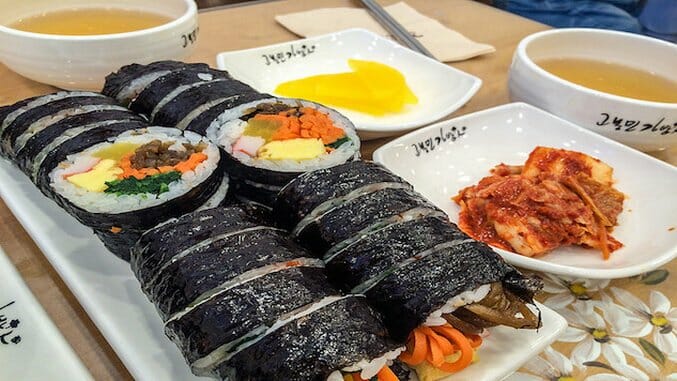5 Easy-to-Find Vegetarian (and Vegan) Dishes in Korea
Photos by Karin-Marijke Vis
How does one manage vegetarianism in Korea without knowing the language? Being a plant-based eater doesn’t exactly help as Koreans have an increasing appetite for meat dishes while fish has always been part of their staple diet.
But, of course, with some good will, hand gestures and a few basic tricks you will quickly learn not just how to survive but, even better, to indulge in Korea’s culinary delights, some of which are based on surprisingly simple ingredients.
1. Kimbap, or gimbap
Kim, or gim means “seaweed,” and kimbap are Korean seaweed rice rolls. It’s the Korean version of the generally better known Japanese sushi.
Kimbap restaurants offer a list of varieties, including for take-out, but the basic and cheapest one, on top of the menu list, generally includes yellow pickled radish, egg, spinach, sliced carrot and ham. Sometimes a slice of surimi is added or comes instead of the ham. So while not a vegetarian dish in itself, it is easy to order as such, as well as in a vegan version.
So how do you ask for a vegetarian/vegan version?
– Ask for yatze kimbap — yatze, or yachae means vegetables.
– Kimbap ingredients are always visible in containers as the food is prepared on a counter along the windowpane of the restaurant rather than in the kitchen. Simply point at the ingredients you don’t want and make a ‘no’ signal with your finger, or cross your lower arms – a common gesture in Korea to indicate “no,” “no have,” or “not possible.”
2. Bibimbap
 Remember the bap? Here’s another steamed rice dish. Bibim means “mixed,” warranting a mixed steamed rice dish. You’ll get a bowl with colorfully displayed vegetables and mushrooms topped with a fried egg and a stainless steel bowl with hot rice and a side dish with gochujang, a thick, deep-red chili paste.
Remember the bap? Here’s another steamed rice dish. Bibim means “mixed,” warranting a mixed steamed rice dish. You’ll get a bowl with colorfully displayed vegetables and mushrooms topped with a fried egg and a stainless steel bowl with hot rice and a side dish with gochujang, a thick, deep-red chili paste.
On the table you’ll find an additional array of side dishes, most of them vegetables and mushrooms. Tofu, meat and/or fish dishes may be part of them as well.
You mix the rice with the contents of your bowl, adding as much spicy sauce as you like, and eat it with your spoon (in Korea rice is eaten with a spoon), while nibbling from the side dishes with your chop sticks. Is a side dish empty and you’d like more? Just ask for a refill — it’s included in the price.
While the egg is an integral part of the mixture, you can order your bibimbap without it for a vegan alternative:
– Gyeran means egg, and to ask to leave out the egg you can say, “Gyeran pe djuseo” (pe means “no,” and djuseo means “please” — no egg please).
– Or say “Gyeran mot mogoyo” (“egg can’t eat”).
3. Jeongsik
-

-

-

-

-

-

-

-

-

-

-

-

-

-

-

-

-

-

-

-

-

-

-

-

-

-

-

-

-

-

-

-

-

-

-

-

-

-

-

-

 Jeongsik, also called baekban jeongsik, is Korea’s set meal. A fixed price which gives you a bowl of steamed rice and a number of side dishes (banchan), a perfect way to try a variety of Korean food. If you finish a dish (or your rice), you can ask for more.
Jeongsik, also called baekban jeongsik, is Korea’s set meal. A fixed price which gives you a bowl of steamed rice and a number of side dishes (banchan), a perfect way to try a variety of Korean food. If you finish a dish (or your rice), you can ask for more. Two handy words to memorize: memil is “buckwheat,” and guksu means “noodles” — these ingredients come in different combinations.
Two handy words to memorize: memil is “buckwheat,” and guksu means “noodles” — these ingredients come in different combinations. Tofu is an excellent meat substitute and many Korean restaurants have tofu dishes on their menu. Dubu jorim, braised tofu, is a good option for spicy food enthusiasts. Slices of tofu are fried in oil until they are crisp and then braised in a mixture of soya sauce, garlic, onion, green onion, salt, hot pepper flakes, sugar and sesame seeds. The braised tofu is served with a number of banchan, just as with the aforementioned dishes.
Tofu is an excellent meat substitute and many Korean restaurants have tofu dishes on their menu. Dubu jorim, braised tofu, is a good option for spicy food enthusiasts. Slices of tofu are fried in oil until they are crisp and then braised in a mixture of soya sauce, garlic, onion, green onion, salt, hot pepper flakes, sugar and sesame seeds. The braised tofu is served with a number of banchan, just as with the aforementioned dishes.






































